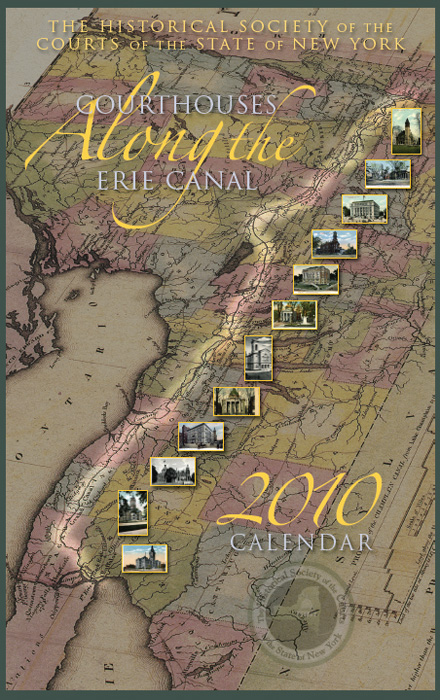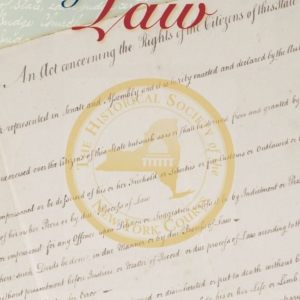Description
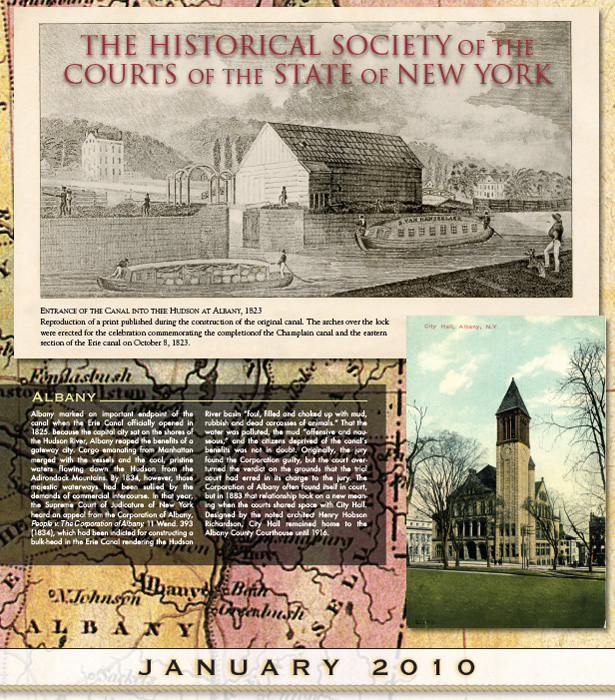
Albany
February 2010
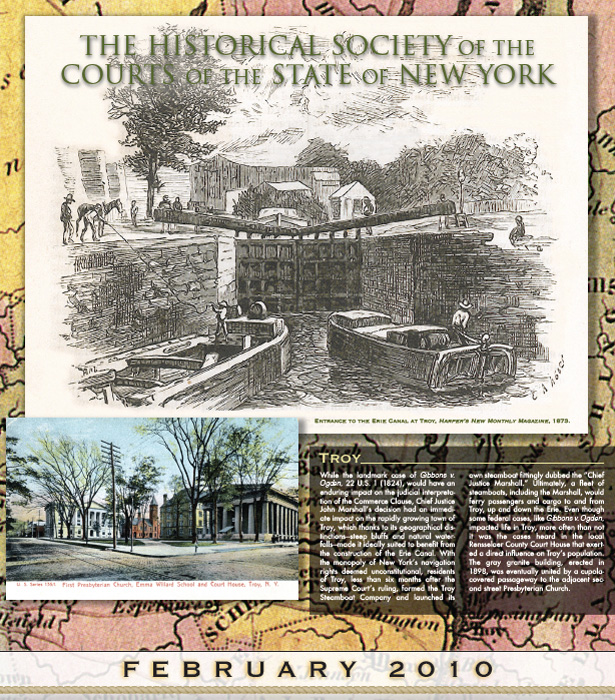
Troy
While the landmark case of Gibbons v. Ogden, 22 U.S. 1 (1824), would have an enduring impact on the judicial interpretation of the Commerce Clause, Chief Justice John Marshall’s decision had an immediate impact on the rapidly growing town of Troy, which thanks to its geographical distinctions—steep bluffs and natural waterfalls—made it ideally suited to benefit from the construction of the Erie Canal. With the monopoly of New York’s navigation rights deemed unconstitutional, residents of Troy, less than six months after the Supreme Court’s ruling, formed the Troy Steamboat Company and launched its own steamboat fittingly dubbed the ‘Chief Justice Marshall.’ Ultimately, a fleet of steamboats, including the Marshall, would ferry passengers and cargo to and from Troy, up and down the Erie. Even though some federal cases, like Gibbons v. Ogden, impacted life in Troy, more often than not it was the cases heard in the local Rensselaer County Court House that exerted a direct influence on Troy’s population. The gray granite building, erected in 1898, was eventually united by a cupola covered passageway to the adjacent second street Presbyterian Church.
March 2010
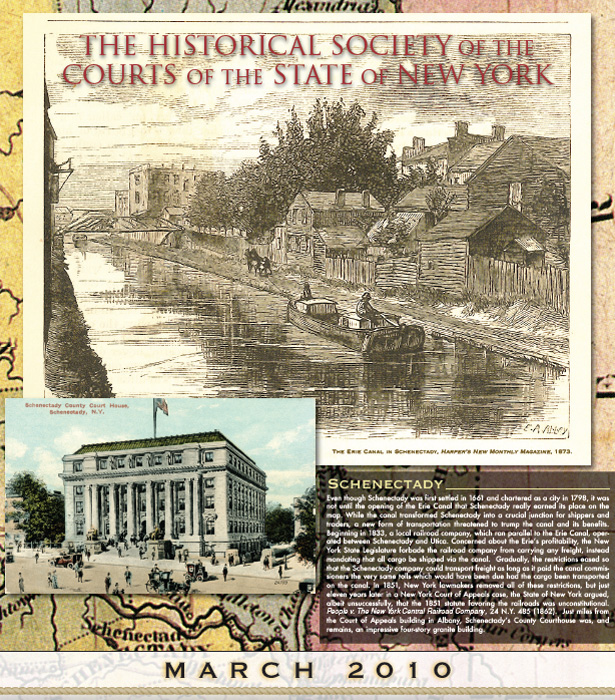
Schenectady
Even though Schenectady was first settled in 1661 and chartered as a city in 1798, it was not until the opening of the Erie Canal that Schenectady really earned its place on the map. While the canal transformed Schenectady into a crucial junction for shippers and traders, a new form of transportation threatened to trump the canal and its benefits. Beginning in 1833, a local railroad company, which ran parallel to the Erie Canal, operated between Schenectady and Utica. Concerned about the Erie’s profitability, the New York State Legislature forbade the railroad company from carrying any freight, instead mandating that all cargo be shipped via the canal. Gradually, the restrictions eased so that the Schenectady company could transport freight as long as it paid the canal commissioners the very same tolls which would have been due had the cargo been transported on the canal. In 1851, New York lawmakers removed all of these restrictions, but just eleven years later in a New York Court of Appeals case, the State of New York argued, albeit unsuccessfully, that the 1851 statute favoring the railroads was unconstitutional. People v. The New York Central Railroad Company, 24 N.Y. 485 (1862). Just miles from the Court of Appeals building in Albany, Schenectady’s County Courthouse was, and remains, an impressive four-story granite building.
April 2010
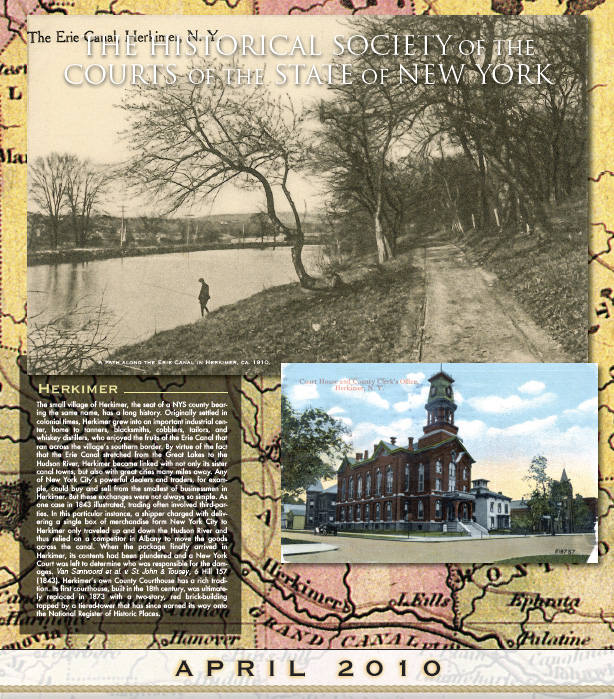
Herkimer
The small village of Herkimer, the seat of a NYS county bearing the same name, has a long history. Originally settled in colonial times, Herkimer grew into an important industrial center, home to tanners, blacksmiths, cobblers, tailors, and whiskey distillers, who enjoyed the fruits of the Erie Canal that ran across the village’s southern border. By virtue of the fact that the Erie Canal stretched from the Great Lakes to the Hudson River, Herkimer became linked with not only its sister canal towns, but also with great cities many miles away. Any of New York City’s powerful dealers and traders, for example, could buy and sell from the smallest of businessmen in Herkimer. But these exchanges were not always so simple. As one case in 1843 illustrated, trading often involved third-parties. In this particular instance, a shipper charged with delivering a single box of merchandise form New York City to Herkimer only traveled up and down the Hudson River and thus relied on a competitor in Albany to move the goods across the canal. When the package finally arrived in Herkimer, its contents had been plundered and a New York Court was left to determine who was responsible for the damages. Van Santvoord et al. v. St. John & Tousey, 6 Hill 157 (1843). Herkimer’s own County Courthouse has a rich tradition. Its first courthouse, built in the 18th century, was ultimately replaced in 1873 with a two-story, red brick-building topped by a tiered-tower that has since earned its way onto the National Register of Historic Places.
May 2010
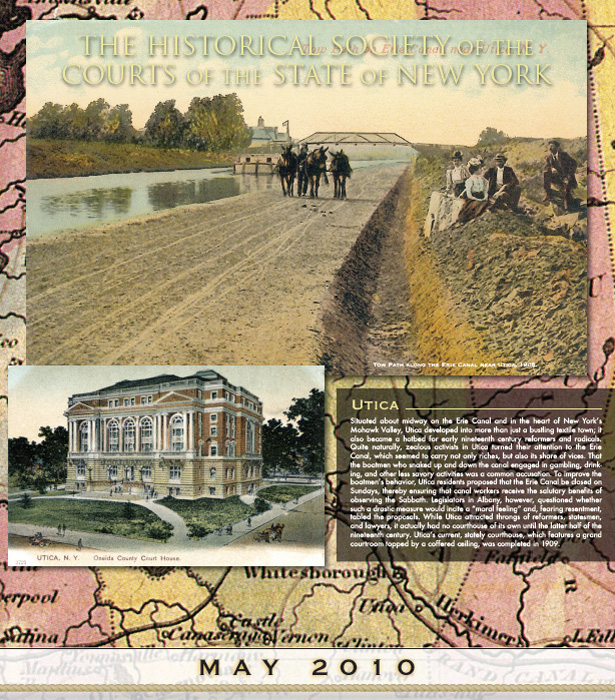
Utica
Situated about midway on the Erie Canal and in the heart of New York’s Mohawk Valley, Utica developed into more than just a bustling textile town; it also became a hotbed for early nineteenth century reformers and radicals. Quite naturally, zealous activists in Utica turned their attention to the Erie Canal, which seemed to carry not only riches, but also its share of vices. That the boatmen who snaked up and down the canal engaged in gambling, drinking, and other less savory activities was a common accusation. To improve the boatmen’s behavior, Utica residents proposed that the Erie Canal be closed on Sundays, thereby ensuring that canal workers receive the salutary benefits of observing the Sabbath. Legislators in Albany, however, questioned whether such a drastic measure would incite a ‘moral feeling’ and, fearing resentment, tabled the proposals. While Utica attracted throngs of reformers, statesmen, and lawyers, it actually had no courthouse of its own until the latter half of the nineteenth century. Utica’s current, stately courthouse, which features a grand courtroom topped by a coffered ceiling, was completed in 1909.
June 2010

Rome
On July 4, 1817, construction of the Erie Canal began as the ceremonial first shovel hit earth in Rome. Rome’s central location within the state at the base of the Adirondack Mountains rendered it a critical transportation juncture and, once the Erie was complete, many of Rome’s residents profited from its geography via a bountiful commercial trade. Occasionally, however, the canal was also a source of frustration. In 1843, much to the chagrin of local mill owners, the Canal Commissioners of the Erie Canal diverted waters from the Mohawk River that fed Rome’s hungry mills into the Erie Canal. The mill owners unsuccessfully sought relief from the courts, Lynch & Mallory v. Stone et al., 4 Denio 356 (1847). While their mills were temporarily shut down, their county courthouse was subject to even greater misfortune when, in 1848, it burned to the ground. Its replacement, still standing today, incorporated the salvaged columns into a stately building with a copper dome amid a lush planting of trees.
July 2010

Syracuse
The Village of Syracuse was incorporated in 1825, the same year the Erie Canal opened for business. Immediately, the canal’s effect on Syracuse, and particularly its already sizeable salt industry, was palpable. But just as Syracuse merchants moved bushels of salt up and down the canal, a band of Syracuse radicals found another use for the grand new waterway: transporting runaway slaves. Syracuse had become so well-known for harboring runaways that shortly after the passage of the Fugitive Slave Law of 1850, which sought to stem the tide of slaves who escaped to the north, Daniel Webster lambasted Syracuse as a ‘laboratory of abolitionism, libel, and treason,’ and pledged from the balcony of Syracuse’s City Hall that the new Fugitive Slave Law would be fully enforced ‘here in Syracuse.’ Nevertheless, in no small part due to its central location on the Erie Canal, Syracuse continued to serve as an important hub for runaway slaves and maintained its position as a leading center of anti-slavery activity. Just across Clinton Square from the spot where Webster had promoted the Fugitive Slave Law stood Syracuse’s Old County Court House. The Anglo-Norman style building, designed by Nelson White, contained an enormous, sun-drenched courtroom.
August 2010
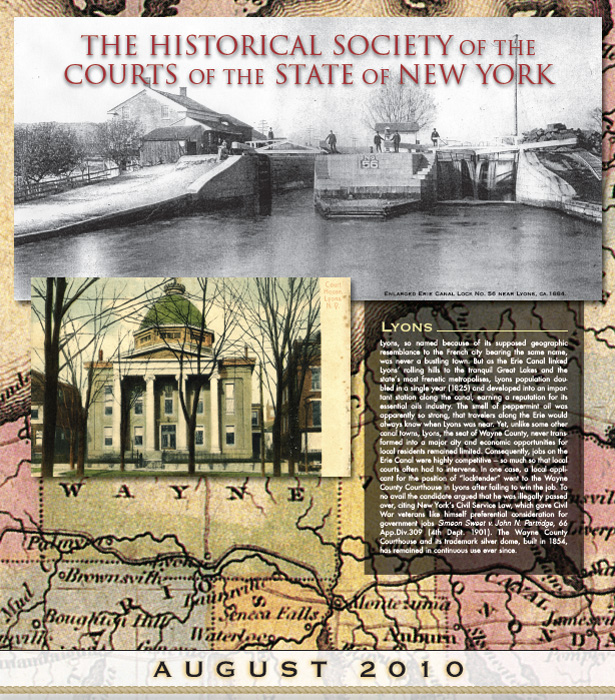
Lyons
Lyons, so named because of its supposed geographic resemblance to the French city bearing the same name, was never a bustling town. But as the Erie Canal linked Lyons’ rolling hills to the tranquil Great Lakes and the state’s most frenetic metropolises, Lyons population doubled in a single year (1825) and developed into an important station along the canal, earning a reputation for its essential oils industry. The smell of peppermint oil was apparently so strong, that travelers along the Erie would always know when Lyons was near. Yet, unlike some other canal towns, Lyons, the seat of Wayne County, never transformed into a major city and economic opportunities for local residents remained limited. Consequently, jobs on the Erie Canal were highly competitive ó so much so that local courts often had to intervene. In one case, a local applicant for the position of ‘locktender’ went to the Wayne County Courthouse in Lyons after failing to win the job. To no avail the candidate argued that he was illegally passed over, citing New York’s Civil Service Law, which gave Civil War veterans like himself preferential consideration for government jobs Simeon Sweet v. John N. Partridge, 66 App.Div.309 (4th Dept. 1901). The Wayne County Courthouse and its trademark silver dome, built in 1854, has remained in continuous use ever since.
September 2010
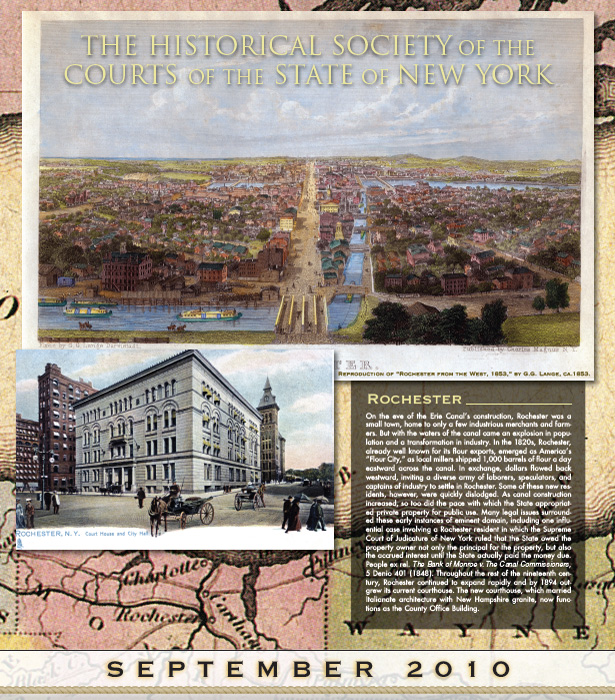
Rochester
October 2010

Albion
Albion was, and remains, a small village situated amid the quiet landscape of Western New York. With its abundance of wheat and thanks to the completion of the Erie, Albion and its bucolic environs earned a reputation as the ‘bread basket of the world.’ As Albion farmers watched their bushels of wheat float down the Erie, cargo boats filled with crops and wares docked on Albion’s shores. These commercial exchanges were an everyday ritual along the Erie, but in one unusual instance, the captain of a cargo boat stationed in Albion found himself in the U. S. Supreme Court after being charged with transporting more than just ordinary goods. The captain had carried a folded note containing an order for tobacco. The question at hand was whether or not the note was considered ‘mailable matter.’ Since a Post-Office route existed between Albion and Rochester it was illegal for the private captain to transport mail between the two cities. Ultimately, the Supreme Court ruled that the tobacco order was clearly ‘mailable’ and its delivery a violation of law, United States v. Bromley, 53 U.S. 88 (1851). Just six years later, Albion was again the center of attention, but this time because of the opening of its impressive county courthouse. The red-brick building featuring 50-foot high Greek columns, a silver dome, and a thunderous bell, still stands today.
November 2010
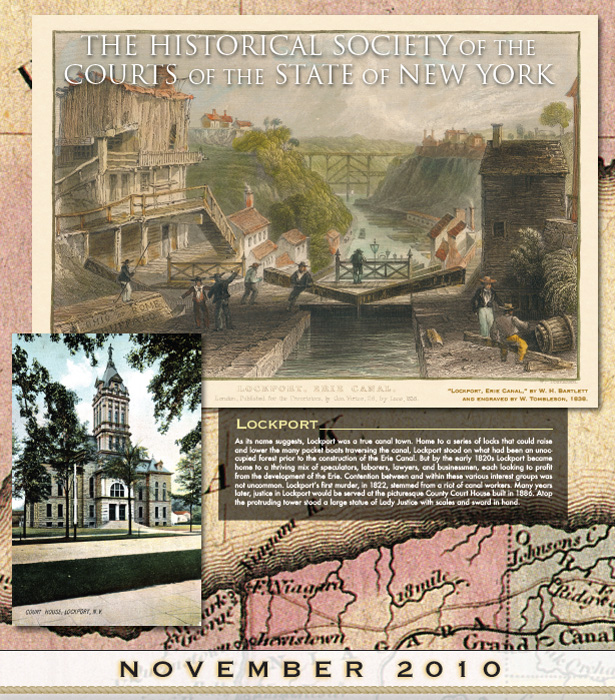
Lockport
As its name suggests, Lockport was a true canal town. Home to a series of locks that could raise and lower the many packet boats traversing the canal, Lockport stood on what had been an unoccupied forest prior to the construction of the Erie Canal. But by the early 1820s Lockport became home to a thriving mix of speculators, laborers, lawyers, and businessmen, each looking to profit from the development of the Erie. Contention between and within these various interest groups was not uncommon. Lockport’s first murder, in 1822, stemmed from a riot of canal workers. Many years later, justice in Lockport would be served at the picturesque County Court House built in 1886. Atop the protruding tower stood a large statue of Lady Justice with scales and sword in hand.
December 2010
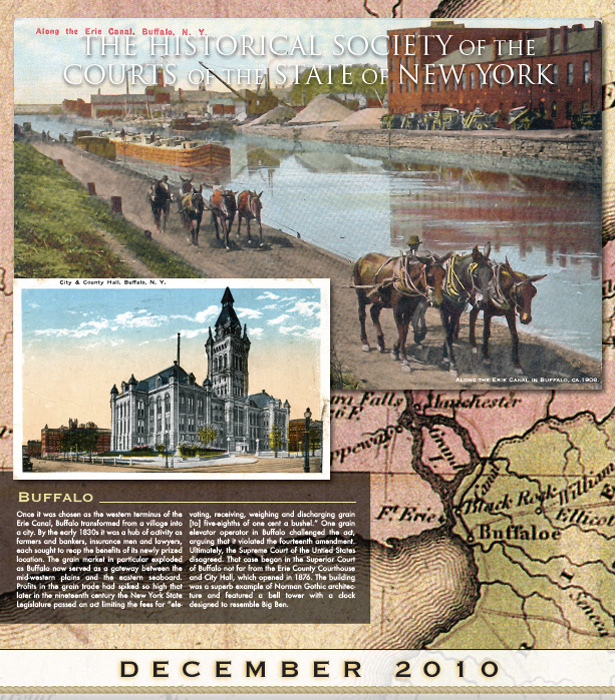
Buffalo
Once it was chosen as the western terminus of the Erie Canal, Buffalo transformed from a village into a city. By the early 1830s it was a hub of activity as farmers and bankers, insurance men and lawyers, each sought to reap the benefits of its newly prized location. The grain market in particular exploded as Buffalo now served as a gateway between the mid-western plains and the eastern seaboard. Profits in the grain trade had spiked so high that later in the nineteenth century the New York State Legislature passed an act limiting the fees for ‘elevating, receiving, weighing and discharging grain [to] five-eighths of one cent a bushel.’ One grain elevator operator in Buffalo challenged the act, arguing that it violated the fourteenth amendment. Ultimately, the Supreme Court of the Untied States disagreed. That case began in the Superior Court of Buffalo not far from the Erie County Courthouse and City Hall, which opened in 1876. The building was a superb example of Norman Gothic architecture and featured a bell tower with a clock designed to resemble Big Ben.

